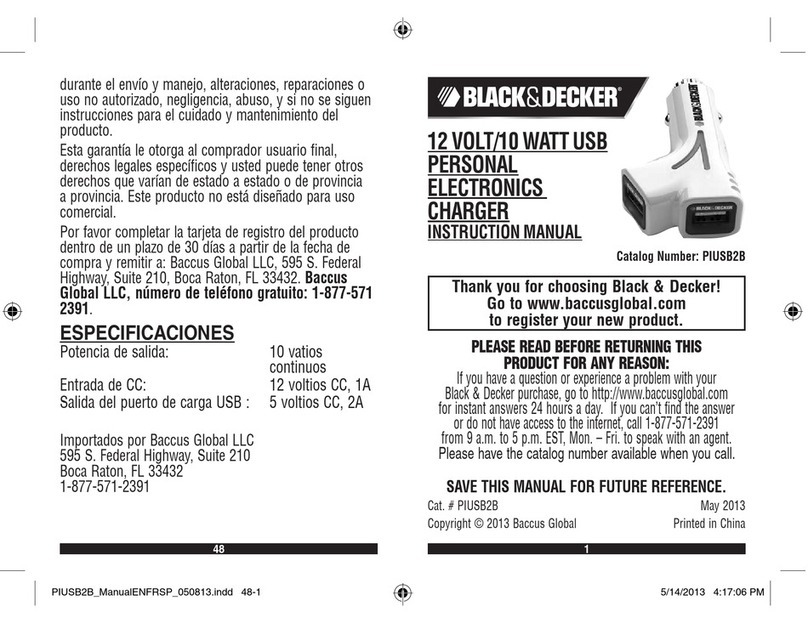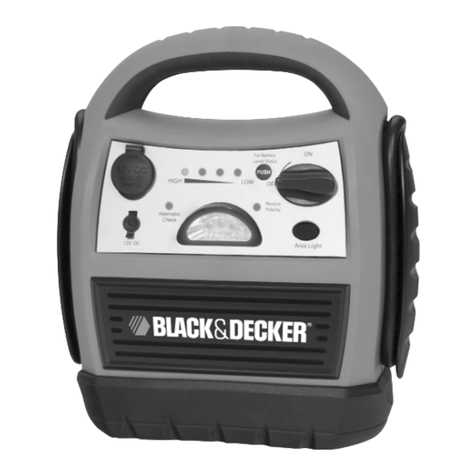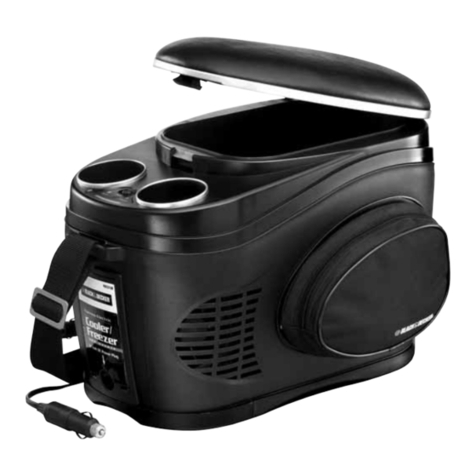
Connection to Power Source
The Power Inverter comes equipped with a DC Accessory Outlet Plug and Battery Clips for connection to a
power source.
Connecting to a Power Source Using the DC Accessory Outlet Plug
(Up to 90W only)
The DC Accessory Outlet Plug is suitable for operating the inverter at power outputs
up to 90 watts and has overload protection at 90W to prevent you blowing the fuse
if you connect a higher rated appliance. The tip of the plug is positive (+) and the
side contact is negative (–).
The opposite end of the DC Accessory Outlet Plug has a unique connector fitted
to it which will allow it to be only fitted into the socket on the rear of the unit when
there are NO battery clips connected to the unit. This is a safety feature and the
design of the plug also covers the positive (+) terminal to prevent both leads being
connected at the same time.
Connect the inverter to the power source by inserting the DC Accessory Outlet Plug firmly into the accessory
outlet of a vehicle or other DC power source.
CAUTIONS
• Connect directly to power source using the included Battery Clips when operating above 90 watts.
• Do not use with positive ground electrical systems.
• Reverse polarity connection will result in a blown fuse and may cause permanent damage to the
inverter.
Notes: Most vehicle accessory outlet circuits have fuses rated at 15 to 20 amps or greater. To operate at full wattage, either use
the battery clip cable (supplied) or directly wire to the power source with user-supplied wire and fuse. The majority of mod-
ern automobiles, RVs and trucks are negative ground.
Once properly connected to a 12 volt DC power source and switched on, the green Power LED Indicator lights
indicating that the Inverter is functioning properly and the 90W logo will light up to show you can only power
devices up to 90W from this connection. If either the yellow low input voltage LED Indicator or red Fault LED
Indicator lights, indicating a fault condition exists, refer to the “Troubleshooting” section of this Instruction
Manual.
Connecting to a Power Source Using the Provided Battery Clips
Use the provided Battery Clips (with cables) to connect the Power Inverter directly to the 12 volt power source
as follows:
1. Check to make sure the inverter’s Power Pushbutton has been pressed OFF (no LEDs are lit) and that no
flammable fumes are present in the installation area.
2. Connect the red cable to the red post on the back of the inverter . Connect the red Battery Clip to the
positive terminal of the battery.
3. Connect the black cable to the black post on the back of the inverter. Connect the black Battery Clip to the
negative terminal of the battery.
4. Make sure that all connections between cables and terminals are secure.
5. Once properly connected to a 12 volt power source and switched on, the green power LED indicator lights
indicating that the inverter is functioning properly and both the 100W and 500W logos will light up to show
what devices you can power.
Direct Hardwiring to Power Source (optional connection method; hardware not included)
WARNING: It is not recommended to install with cables longer than 10ft as this can adversely effect the
operation of your inverter.
As this unit can be directly hard wired it has wall mount features built in to secure it in the desired location. The
diagram below shows you how to do this.
Use #6 AWG wire if the inverter to power source connection is 6 feet or less. For cable lengths up to 10ft use
#4 AWG wire. In either case, protect the positive (+) wire from shorts by installing a 60 ANL fuse or circuit
breaker close to the DC power source (battery) terminal.
1. Check to make sure the inverter’s Power Pushbutton has been pressed OFF (no LEDs are lit) and that no
flammable fumes are present in the installation area.
2. Identify the positive (+) and negative (–) DC power source (battery) terminals.
3. Install a fuse holder or breaker close to the positive (+) terminal of the DC source (battery).
4. Connect a length of wire on one side of the fuse holder or circuit breaker. Connect the other end of the wire
to the positive (+) terminal of the inverter.
5. Connect a length of wire between the inverter’s negative (–) terminal and the DC power source negative (–)
terminal.
6. Connect a short length of wire to the other terminal of the fuse holder or circuit breaker. Mark it “positive”
or “+”.
7. Connect the free end of the fuse or breaker wire to the positive (+) terminal of the DC power source
(battery).
8. Insert a fuse appropriate to the inverter in the fuse holder.
9. Test the inverter by turning it on and plugging in a 100 watt lamp or equipment.
10. If the inverter is not properly operating, then refer to the Troubleshooting section of this manual.
CAUTION
•The cable and fuse sizes given here are a general recommendation. You should always consult your National
Electrical Code prior to beginning each specific installation.
• Loose connectors may cause overheated wires and melted insulation.
• Check to make sure you have not reversed the polarity. Damage due to reversed polarity is not covered by
our warranty.
Connection To Load
The Power Inverter is equipped with dual standard North American three-prong type outlets. Plug the cord
from the equipment you wish to operate into the AC receptacle(s). Make sure the combined load requirement
of your equipment does not exceed maximum continuous power.
The Power Inverter is engineered to be connected directly to standard electrical and electronic equipment in
the manner described above. Do not connect the Power Inverter to household or RV AC distribution wiring. Do
not connect the Power Inverter to any AC load circuit in which the neutral conductor is connected to ground
(earth) or to the negative of the DC (battery) source.
WARNING: Do not connect to AC distribution wiring!
Rated Versus Actual Current Draw of Equipment
Most electrical tools, appliances, electronic devices and audio/visual equipment have labels that
indicate the power consumption in amps or watts. Be sure that the power consumption of the item to be
operated is below 500 watts. If the power consumption is rated in amps AC, simply multiply by the AC volts
(115) to determine the wattage.
Resistive loads are the easiest for the inverter to run; however, it will not run larger resistive loads (such as
electric stoves and heaters), which require far more wattage than the inverter can deliver. Inductive loads (such
as TVs and stereos) require more current to operate than do resistive loads of the same wattage rating.
Inductive loads, i.e. power tools
Note: Some motors used in power tools, refrigerators and pumps require a very high surge current to start.
This inverter can handle a surge twice it’s rated power but some motors require more than this when started.
The inverter will not be harmed if you try to start such a product it will simply shutdown on overload.
For safety reasons, the unit will simply shut down if it is overloaded. To restart the unit, simply unplug all
devices plugged into the unit; disconnect the unit from any 12 volt DC power source; then reconnect the unit
BEFORE plugging the appliance back in.
Operation of the 115 Volt AC Outlets
1. Connect the inverter to a functioning 12 volt DC power source as described in this Instruction
Manual. If using the 12 Volt DC Vehicle Accessory Adapter, rotate the vehicle accessory plug slightly to
make sure there is good contact. Make sure there is adequate space for proper ventilation of the inverter.
2. Press the Power Pushbutton to turn the unit ON.
3. The green Power LED Indicator will light, indicating a proper connection. If either the yellow low input
voltage LED Indicator or red Fault LED Indicator lights, indicating a fault condition exists, refer to the
“Troubleshooting” section of this Instruction Manual.
4. If the Inverter does not work, make sure the ignition/accessory switch is actually powering the
accessory outlet. Some vehicles require the ignition switch to be turned on.
5. Plug the (110/120 volt AC) appliance into one of the Inverter’s three-prong AC outlet and operate normally.
Note: The Inverter will not operate appliances and equipment that generate heat, such as hair dryers, electric blankets, microwave
ovens and toasters.
Remember to disconnect the inverter from any power source when not in use.
Operation of the USB Charging Port
1. Connect the inverter to a functioning 12 volt DC power source as described in this Instruction Manual. If
using the 12 Volt DC Vehicle Accessory Adapter, rotate the vehicle accessory plug slightly to make sure
there is good contact. Make sure there is adequate space for proper ventilation of the
inverter.
2. Press the Power Pushbutton to turn the unit ON.
3. The green Power LED Indicator will light, indicating a proper connection. If either the yellow Input Fault
LED Indicator or red Output Fault LED Indicator lights, indicating a fault condition exists, refer to the
“Troubleshooting” section of this Instruction Manual.
4. If the Inverter does not work, make sure the ignition/accessory switch is actually powering the
accessory outlet. Some vehicles require the ignition switch to be turned on.
5. Plug the USB-powered device into the inverter’s USB Charging Port and operate normally.
Notes: This unit’s USB Charging Port does not support data communication. It only provides 5 volts/500mA DC power to an exter-
nal USB-powered device.
Remember to disconnect the inverter from any power source when not in use.
Not all mobile phones are provided with a charging cable, they are normally data cables which are not supported by this
device - please check with your mobile phone manufacturer for the
correct charging cable.
Protective Features
The inverter monitors the following conditions:
Low Battery Voltage — This condition is not harmful to the inverter, but could damage the power source, so
the inverter will automatically shut down when input voltage drops below 10.5 ± 0.3 volts DC.
Input Voltage Too High — The inverter will automatically shut down when DC input voltage exceeds 15.5 ±
0.5 volts, as this can harm the unit.
Thermal Shutdown Protection — The inverter will automatically shut down when the unit becomes overheated.
Overload/Short Circuit Protection — The inverter will automatically shut down when a short circuit occurs.
Operating Tips
The inverter should only be operated in locations that are:
DRY — Do not allow water or other liquids to come into contact with the inverter.
COOL — Surrounding air temperature should ideally be 10-20°C (50-68°F). Keep the inverter away from direct
sunlight, when possible.
WELL-VENTILATED — Keep the area surrounding the inverter clear to ensure free air circulation around
the unit. Do not place items on or over the inverter during operation. The unit will shut down if the internal
temperature gets too hot. The inverter will auto-reset after it cools down.
SAFE — Do not use the inverter near flammable materials or in any locations that may accumulate flammable
fumes or gases. This is an electrical appliance that can briefly spark when electrical connections are made or
broken.
CARE AND MAINTENANCE
Storage
1. Ideal storage temperature range is 0-40°C (32-104°F).
2. Store and use the PI500BB in a cool, dry place with adequate ventilation for all-around air
circulation.
3. Avoid locations that are exposed to heating units, radiators, direct sunlight, or excessive humidity or
dampness.
Fuse Replacement
This inverter is equipped with multiple internal fuses. Normally, these fuses will not “blow” unless there is a
serious problem inside the unit. Internal fuses are replaceable; however, only trained personnel should attempt
fuse replacement. If the unit is damaged during fuse replacement, the warranty may be voided.
The fuse in the DC Accessory Outlet Plug is user-replaceable. Make sure to first disconnect the Outlet Plug
from any 12 volt DC power source; then replace the fuse with one of the same rating and type.
TROUBLESHOOTING
Common Audio/Visual Problems
Problem Explanation/Recommendation
Buzzing sound in audio
systems Some inexpensive stereo systems and boom boxes make a buzzing
sound when operated from the inverter, because the power supply in
the electronic device does not properly filter the modified sine wave
produced by the inverter. The only solution to this problem is to use a
sound system that has a higher quality power supply.
Problem: Television
Interference The inverter is shielded to minimize interference with TV signals.
However, in some instances, some interference may still be visible,
especially when the TV signal is weak. Try the following to improve
the picture:
1.Move the Inverter as far away as possible from the TV set, the antenna, and
the antenna cables. Use a short AC extension cord, if necessary.
2.Adjust the orientation of the antenna cables, and the TV power cord to mini-
mize interference.
3.Make sure that the antenna feeding the TV provides an adequate (snow-
free) signal and that high quality, shielded antenna cable is used.
Fault Conditions
Input
LED
Color
Output
LED
Color
Possible Cause Recommendation
Yellow Low input voltage Start Engine
Red Battery voltage below
10.5 volts Recharge battery or check DC power supply.
Red Equipment being oper-
ated draws too much
power
• Reduce load to maximum 500 watts if connected via
battery clips.
• Reduce load to maximum 90 watts if connected via the
12V dc accessory plug.
• Connect directly to power source using the included
Battery Clips when operating above 100 watts.
Red Inverter in thermal
shutdown condition Allow inverter to cool down. Ensure there is adequate
ventilation around the load is no more than 500 watts for
continuous operation.
Red AC output is shorted Unplug the AC appliance. Disconnect the unit from any 12
volt DC power source. Check the appliance cord. Refer to
the Service Information section that follows to contact a
Black & Decker Service Center.
Red or Yellow Fault LED Indicator Lights
The red Fault LED indicates inverter shutdown from input fault, over temperature fault or overload / short
circuit fault and the yellow Fault LED indicates an input fault.
FULL TWO-YEAR HOME USE WARRANTY
Black & Decker (U.S.) Inc. warrants this product for two years against any defects in material or workmanship.
The defective product will be replaced or repaired at no charge in either of two ways.
The first, which will result in exchanges only, is to return the product to the retailer from whom it was
purchased (provided that the store is a participating retailer). Returns should be made within the time period
of the retailer’s policy for exchanges (usually 30 to 90 days after the sale). Proof of purchase may be required.
Please check with the retailer for their specific return policy regarding returns that are beyond the time set for
exchanges.























